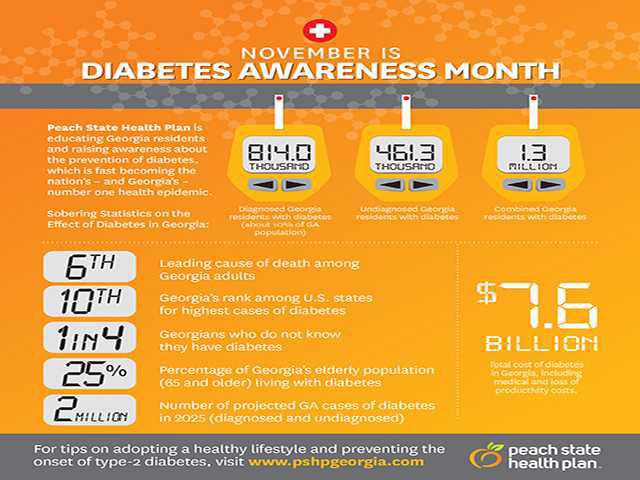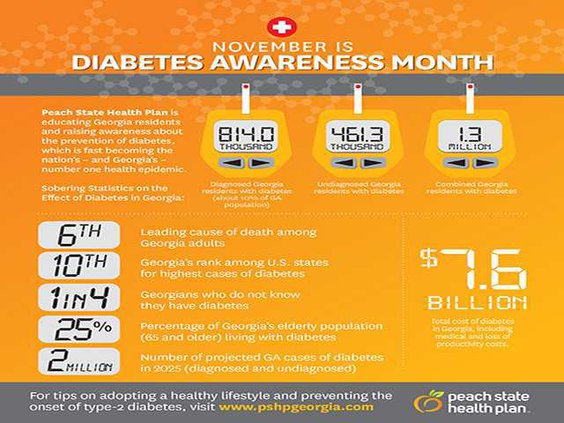According to the American Diabetes Association, diabetes was the seventh-leading cause of death in the United States in 2010 based on the 69,071 death certificates in which the disease was listed as the underlying cause of death.
The scary reality is that those numbers are likely higher because diabetes may be underreported as a cause of death. The ADA reported that studies have found that only 35 percent to 40 percent of people with diabetes who died had the disease listed anywhere on their death certificate, and about 10 percent to 15 percent had it listed as the underlying cause of death.
The ADA added that of the 29.1 million Americans who had diabetes in 2012, 8.1 million went undiagnosed.
The World Health Organization reports that total deaths from diabetes are projected to rise by more than 50 percent in the next 10 years and are projected to increase by more than 80 percent in upper- and middle-income countries.
Worse yet is that Georgia is part of the “diabetes belt,” meaning the disease is prevalent in the region, according to a recent press release issued by Peach State Health Plan.
According to the PSHP, the total cost of diabetes in Georgia, including medical and loss of productivity, is $7.6 billion, and it is the sixth-leading cause of death among Georgia adults.
What is diabetes?
Diabetes is a disease that leads to high levels of glucose (blood sugar) and happens when the body does not make any, or enough, insulin or does not use insulin well.
There are two commonly recognized forms of diabetes, type 1 and type 2.
In type 1 diabetes, the body does not produce insulin, which is the hormone the body needs to get glucose from the bloodstream into the cells. Typically, the human body breaks down the sugars and starches that are eaten into glucose, which the body then uses for energy.
Type 1 diabetes is usually diagnosed in children and young adults and was previously known as juvenile diabetes and sometimes referred to as insulin-dependent diabetes. The ADA reports that only 5 percent of people with diabetes have this form of the disease.
Type 2 diabetes is the more common form. In type 2, sometimes referred to as insulin-resistant or adult-onset diabetes, the body does not use insulin properly. The pancreas, which produces insulin, is not able to keep up or make enough insulin to keep glucose at normal levels.
Type 1 risk factors and recommendations
According to the Mayo Clinic, there are some known risk factors for type 1 diabetes. As with many diseases family history is a factor that can’t be controlled. Studies show that anyone with a parent or sibling with type 1 diabetes has a slightly higher risk of developing the disease.
Something else beyond control is genetics. Studies have shown that the presence of certain genes increases the risk for type 1 diabetes.
Where you live is a risk factor. According to the Mayo Clinic, the incidence of type 1 diabetes tends to increase the farther away from the equator you live. Studies have shown that people who live in Finland have the highest incidence of type 1 compared to people in the United States.
The Mayo Clinic also reported that age is a factor. Although type 1 diabetes can appear at any age, it appears at two noticeable peaks. The first peak occurs in children between ages 4 and 7, and the second is in children between ages 10 and 14.
There is no cure for type 1 diabetes, but there are many successful ways to manage the disease and live a long life.
Work closely with your health-care team to develop a plan that best meets your needs. The most important aspect of managing type 1 diabetes is monitoring your blood glucose levels.
Exercise, food, stress, medication and other daily factors affect your blood glucose levels. In order to monitor these levels, you will need a glucose meter. There are many types of meters available, and you should discuss the meters and test strips with your doctor and insurance company to decide which model works best for you under your current medical plan.
Most meters work the same way. You insert the test strip into the device, prick a clean fingertip with a lancet to draw a drop of blood, place the blood on the test strip and wait for the meter to show the results.
Another part of managing type 1 is administering insulin when necessary. Again, you will need to work closely with your physician. According to the ADA, there are more than 20 types of insulin sold in the United States. Each varies in how it works in the body. Insulin can’t be taken orally and must either be injected into the body through a syringe or through the use of an insulin pump.
An insulin pump is about the size of a cellphone worn outside the body and attaches to a tube that is inserted in the abdomen.
Your health-care team should include a registered dietitian. People with type 1 diabetes need to understand how different foods affect blood glucose. You’ll need to learn how to count the amount of carbohydrates in the foods you eat so you can give yourself enough insulin to properly break down those carbohydrates.
Despite many thinking to the contrary, daily exercise and activity is vital in managing type 1 diabetes. The Mayo Clinic recommends you get approval from, and work with, your physician in developing your exercise plan and aim for at least 30 minutes of aerobic activity most days of the week.
It is important to monitor your glucose levels before and after your exercise routine to see how the activity affected you blood sugar levels.
Type 2 risk factors and recommendations
The jury is still out as to why some people develop type 2 diabetes while others don’t, but the Mayo Clinic did list potential risk factors.
Being overweight is among the primary risk factors for type 2. If you tend to store body fat primarily around the abdomen, the chances of getting type 2 increases greatly. The more fatty tissue you have, the more resistant your cells become to insulin, the Mayo Clinic reported. Inactivity plays a role in being overweight and the less active you are the greater your risk.
As with type 1, family history and age are risk factors, but unlike type 1, type 2 risks increase with age, especially after 45. However, the Mayo Clinic reports that the number of younger kids being diagnosed is dramatically increasing, primarily based on obesity, inactivity and poor nutrition.
Many of the methods used to treat type 1 are used to treat type 2 diabetes, including proper blood monitoring, physical activity and a better diet. Instead of insulin injection, you are likely going to be treated with insulin therapy or medication.
Some people who have type 2 diabetes can achieve their target blood-sugar levels with diet and exercise alone. The Mayo Clinic suggests this diet be centered on high-fiber, low-fat foods like fruits, vegetables and whole grains while reducing animal products, refined carbohydrates and sweets.
Low glycemic-index foods also may be helpful. The glycemic index is a measure of how quickly a food causes a rise in your blood sugar. Foods with a high glycemic index raise your blood sugar quickly. Low glycemic foods may help you achieve a more stable blood-sugar level. Foods with a low glycemic index typically are foods that are higher in fiber.
An important thing to note is that based on statistics, you are not alone if diagnosed with diabetes. Reach out and get local support.
The ADA has a resource and support group you can join online at www.diabetes.org
The ADA has a local office in Savannah that is committed to educating the public about the disease as well as offering support those living with the disease. It is located at 340 Eisenhower Drive, Suite 102, Savannah, GA 31406. For more information, call 912-353-8110.
Make the silent killer pay
November is Diabetes Awareness Month


Sign up for our e-newsletters